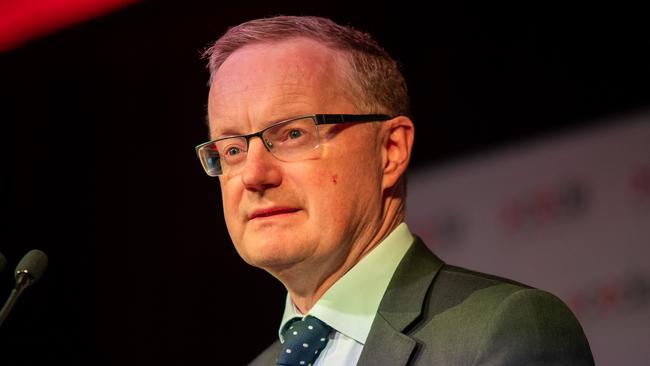Record-low rates to spark house price jump
House prices are set to bounce back after the Reserve Bank slashed the official interest rate.

House prices are set to bounce back after the Reserve Bank slashed the official interest rate to 1 per cent yesterday, ushering in Australia’s lowest borrowing costs since Federation.
The second rate cut in consecutive months would hand households with loans of $1 million an extra $1700 if banks passed on the full 25-basis-point RBA rate reduction.
But, within hours of the RBA decision, the Commonwealth Bank, National Australia Bank and Westpac decided not to pass on the full savings to borrowers.
ANZ, which was criticised by Josh Frydenberg for failing to deliver a full rate cut following last month’s RBA board meeting, was the only big bank to announce it would pass on the entire saving to customers this time.
Speaking in Darwin last night, Reserve Bank governor Philip Lowe urged the government to borrow to accelerate infrastructure spending across the nation and pursue major structural reforms to stimulate the economy.
Dr Lowe said forecasts for the economy remained reasonable, “with growth around trend expected”, but warned the government against relying on the central bank to drive fiscal growth. Despite global economic headwinds and falling consumer spending, Dr Lowe said an increase in government spending, the strength of the resources sector, a falling Australian dollar and the government’s tax cuts package would help boost household consumption.
“Borrowing costs for almost all borrowers are now the lowest they have ever been,” he said.
With Scott Morrison’s flagship $158 billion income tax cuts package expected to pass through parliament by the end of the week, NAB chief executive and incoming chairman Phil Chronican said getting cash into consumers’ hands was crucial for stimulating economic activity.
Speaking at The Australian’s Competitive Advantage Forum yesterday, Mr Chronican said there had been an economic “impact” from Mr Morrison’s election victory, prospective tax cuts and interest rate reductions.
“Certainly there is some evidence that the negative impacts on the economy with the poor outlook for housing prices is starting to ease off and we may be at the beginning now of the next growth cycle,” Mr Chronican said.
The Prime Minister’s signature election policy to deliver immediate tax relief for Australians was passed through the lower house last night, and the government was confident it would secure the four crossbench votes it needs to win support in the Senate. Labor last night failed in a bid to amend the tax cuts package, using the RBA rate cut to call for the fast-tracking of infrastructure spending and bringing forward stage two of the tax cuts package.
Senior economists predicted the RBA could further reduce the cash rate to as low as 0.5 per cent by early next year.
Speaking at the RBA board dinner, Dr Lowe said the tax relief would help boost growth in incomes which should support household spending.
But Dr Lowe said further stimulus was required to drive economic growth. “As an illustration, the Australian government can borrow for 10 years at around 1.3 per cent — the lowest rate it has faced since Federation in 1901,’’ he said. “It is also able to borrow for 30 years at an interest rate of less than 2 per cent. Private businesses and households also face low borrowing rates. This is not only because official interest rates are low, but because credit spreads are low too.”
The Treasurer, who urged all banks to pass on the rate cut to customers, said the government’s tax cuts package would “boost household consumption and overall economic activity”.
HSBC chief economist Paul Bloxham said the back-to-back rate cuts suggested the RBA had “bigger growth fears” than anticipated and underscored the sense of urgency at the central bank, with a slowing global economy not seen since the European sovereign debt crisis in 2012.
Anthony Albanese yesterday called on the government to lift spending. “Monetary policy can’t do all the heavy lifting,” the Opposition Leader said.
The Australian understands Treasury has been considering the fiscal impact of bringing forward key infrastructure projects, with the government facing challenges to retain its surplus forecasts if it accelerates major projects.
Data this week revealed house prices were bottoming out in Sydney and Melbourne, after falling 15 per cent since mid-2017. But property downturns in Perth, Darwin and regional Western Australia are continuing.
A paper released by the RBA earlier this year found that a 1 per cent drop in interest rates could, over the long term, boost house prices by 17 per cent, allowing for a user cost of 6 per cent, or by 28 per cent if the user cost is 3.5 per cent.
The Commonwealth Bank and NAB, which both passed on the full 25-basis-point rate cut in June, each decided to reduce loan rates by 19 basis points yesterday. Westpac, which denied savers the full rate reduction in June, again withheld the full cut, dropping rates by just 20 basis points. NAB head of retail banking Mike Baird said “decisions like these are difficult” and getting the balance right was an ongoing challenge.
Retirees and savers face the most bruising interest rates on term deposits, slashed to their lowest level since the mid-1950s.
The major banks last year hiked rates out of cycle with the RBA, citing higher funding costs, but failed to reduce rates when those costs dissipated.



To join the conversation, please log in. Don't have an account? Register
Join the conversation, you are commenting as Logout